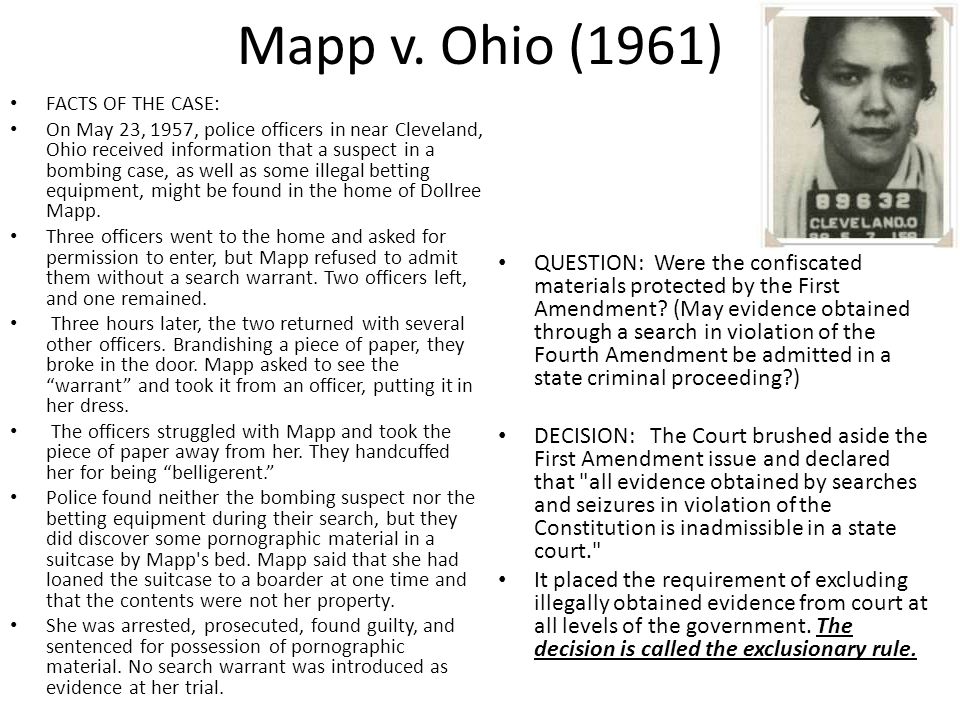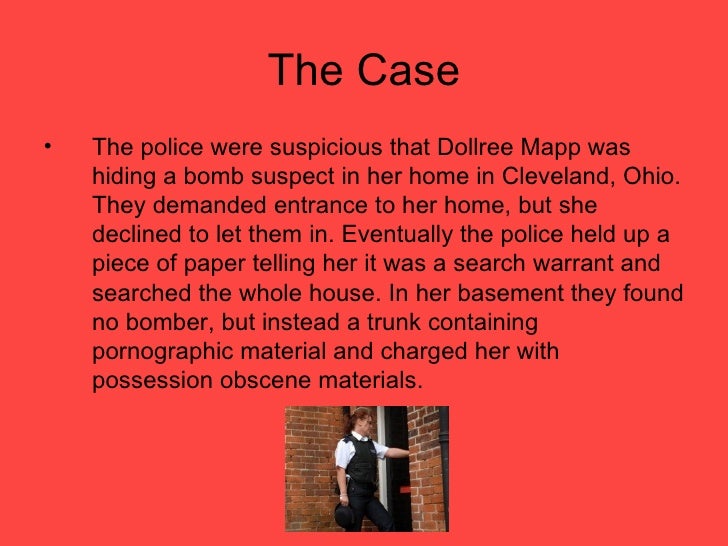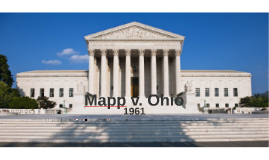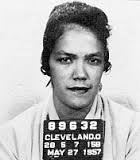Supreme Court on June 19 1961 strengthened the Fourth Amendment protections against unreasonable searches and seizures by making it illegal for evidence obtained by law enforcement without a valid warrant to be used in criminal trials in both federal and state courts. Ohio case in which the US.
Ohio Case Brief for Law Students.

Mapp vs ohio case. This was a huge case because it was violating the 4th and 14th amendmants. The evidence was seized illegally because there was no warrant shown to Dollreee Mapp. Mapps home was searched absent a warrant.
Police believed that Mapp was harboring a suspected bomber and demanded entry. The Supreme Court held that evidence obtained from an unreasonable search and seizure could not be used against the accused in criminal state court. The Supreme Court ruled in favor of Mapp whose home was searched without a warrant by the Cleveland police and whose property was seized during that search.
Ohio addressed this issue and the decision has had a. On May 23 1957 three Cleveland police officers arrived at appellants residence in that city perusing information that a person was hiding out in the home who was wanted for questioning in connection with a recent bombing and that there was a large amount of policy paraphernalia being hidden in the home. Ohio may highlight a potential but not immediately clear violation of citizens rights.
The decision launched the Court on a troubled course of determining how and when to apply the exclusionary rule. The landmark Supreme Court case Mapp v. The 14th amendmant gave blacks the right of citizenship in America.
Mapp was arrested for possessing the pictures and was convicted in an Ohio court. Police officers sought a bombing suspect and evidence of the bombing at the petitioner Miss Mapps the petitioner house. Ohio decided by the US.
Things changed though after the 6-3 decision in Mapp v. Ohio was the first time this Amendment was applied to criminal procedure in State courts. In an opinion authored by Justice Tom C.
Supreme Court on June 19 1961 ruled 63 that evidence obtained in violation of the Fourth Amendment to the US. Ohio addressed this issue and the decision has had a. When she refused they forcibly broke down her door and entered the premises.
The 4th amendmant protects people against illegal search and seizures. In so doing it held that the federal exclusionary rule which forbade the. Clark the majority brushed aside First Amendment issues and declared that all evidence obtained by searches and seizures in violation of the Fourth Amendment is inadmissible in a state court.
Constitution which prohibits unreasonable searches and seizures is inadmissible in state courts. Mapp argued that her Fourth Amendment rights had been violated by the search and eventually took her appeal to United States Supreme. Criminal Procedure Criminal Procedure keyed to Saltzburg Searches and Seizures of Persons and Things.
Black also cites more recent cases that convinced him that the court needs to safeguard individual liberties. In Mapp v Ohio a case that brought all the questions into the spotlight. Case Summary of Mapp v.
When theres room for debate about whether or not a certain practice threatens citizens rights the court should err on the side of protecting citizens. Police officers arrived at her home and demanded entrance. A case such as Mapp v.
The case of Mapp v. The search which did not uncover what police had gone to the residence to find did result in criminal charges against the woman. Dollreee Mapp was tried for having pornographic material in her home.
The search yielded the discovery of material classified as obscene under Ohio state law. No suspect was found but police discovered a trunk of obscene pictures in Mapps basement. Can the police use illegally seized.
A Cleveland Ohio woman Dollree Mapp was suspected of harboring a fugitive in her home. In the case police are said to have gained entry into a womans home after holding up a piece of paper that could not be confirmed to be a warrant. Mapp v Ohio and the The Exclusionary Rule Explained - YouTube.
Mapp V Ohio Equal Protection Clause Court Cases
 Mapp V Ohio 1961 Facts Of The Case On May 23 1957 Police Officers In Near Cleveland Ohio Received Information That A Suspect In A Bombing Case Ppt Download
Mapp V Ohio 1961 Facts Of The Case On May 23 1957 Police Officers In Near Cleveland Ohio Received Information That A Suspect In A Bombing Case Ppt Download
Mapp V Ohio 367 U S 643 1961 The Cleveland Memory Project
 Amazon Com Mapp V Ohio Evidence And Search Warrants Landmark Supreme Court Cases 9780894908576 Persico Deborah A Books
Amazon Com Mapp V Ohio Evidence And Search Warrants Landmark Supreme Court Cases 9780894908576 Persico Deborah A Books
 Dollree Mapp Figure In Landmark Supreme Court Decision In 1961 Dies At 91 The Washington Post
Dollree Mapp Figure In Landmark Supreme Court Decision In 1961 Dies At 91 The Washington Post
 Can The Police Use Evidence They Got Illegally Mapp V Ohio Youtube
Can The Police Use Evidence They Got Illegally Mapp V Ohio Youtube



